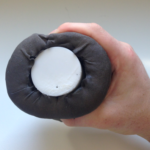Publication
 Tristan Beven, Thuong Hoang, Marcus Carter, Bernd Ploderer, “HandLog: A Deformable Tangible Device for Continuous Input through Finger Flexion”, in OzCHI 2016 Proceedings of the Annual Meeting of the Australian Special Interest Group for Computer Human Interaction,, Launceston, Australia 2016.
Tristan Beven, Thuong Hoang, Marcus Carter, Bernd Ploderer, “HandLog: A Deformable Tangible Device for Continuous Input through Finger Flexion”, in OzCHI 2016 Proceedings of the Annual Meeting of the Australian Special Interest Group for Computer Human Interaction,, Launceston, Australia 2016.
[pdf]
Description
Traditional methods for hand and arm rehabilitation often take place at the clinician’s facility. This requires the use of specialised rehabilitation equipment, only available at a clinic. This can make it difficult to adapt various exercise routines and schedules to suit different patients. Additionally, in-clinic visit for rehabilitation can be costly and time-consuming, especially when for patients living in remote areas. For those that are able to perform home-based rehabilitation, it is also often very costly to install the necessary rehabilitation equipment. Furthermore, without the aid of regular reminders and the visualisation of progress, it is difficult to track and quantify the patient’s recovery over time – for both clinicians and the patients themselves.
To address this problem, we have developed the ‘ArmLog’ prototype. ArmLog senses and communicates bodily information including grip strength and arm movement. The device is a lightweight hand held assessment tool with a soft grip that measures grip strength as well as movement. It is shaped as a cylinder device with the outside sleeve made of soft foam which contains sensors to provide a fine-grained assessment of grip strength and grip location.
This project is significant for research on natural user interfaces (NUIs) as it addresses the question how grip strength can be used as an input to interactive technology. The HandLog has the capability to detect grip strength as well as the location of the grip on the device. In this project, information was used to distinguish grip capabilities between different muscle parts to provide assessment capability in a teleconsultation setting.